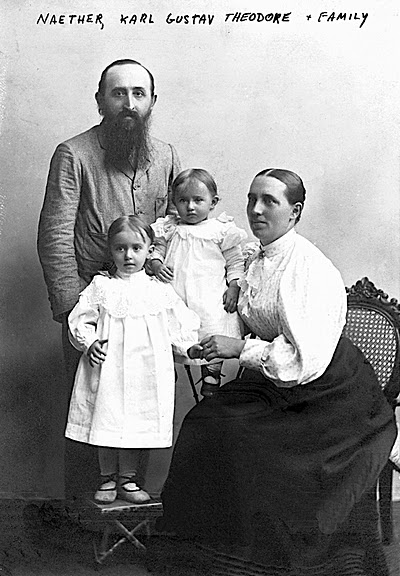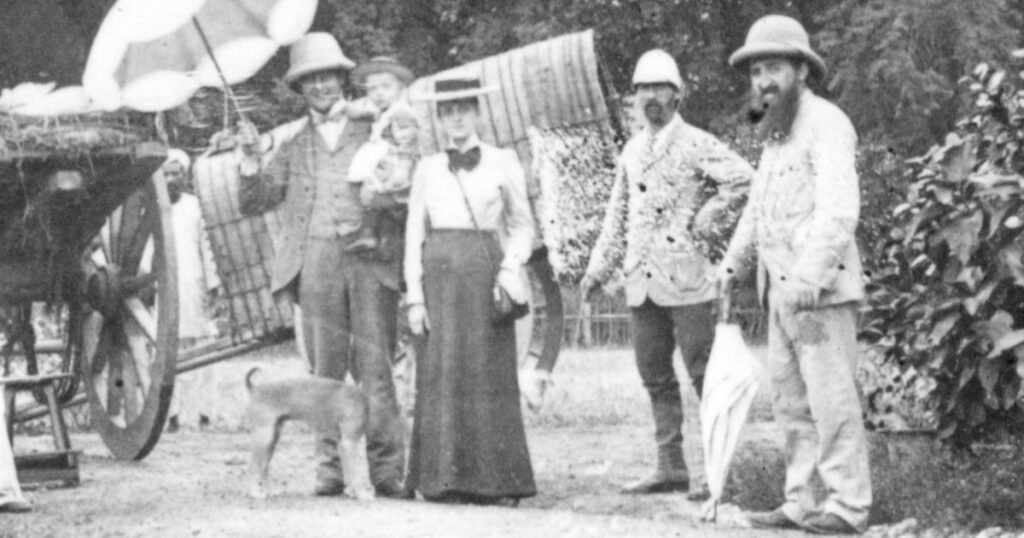by Heather C. Smith
The start of LCMS international missions 125 years ago was neither in the place initially planned, nor through the missionary originally envisioned, nor with the results immediately hoped for. Nevertheless, the faithful labors of the LCMS’s first missionary, Theodore Naether, foreshadowed the tireless service and devotion to the Gospel that would characterize thousands of his successors.
Early life and mission work
Born September 14, 1866, in Bautzen, Saxony, Karl Gustav Theodore Naether was the first child of master cobbler Gustav and his wife, Ida. From a young age Naether showed an interest in mission work. Although a speech impediment prevented his talking until age three, as a teenager he represented his school in a public speaking event, which both his mother and the local pastor took as a sign that he was indeed suited to preaching. Having gained his father’s more reluctant permission, Naether moved to Leipzig in 1883 to study theology and the Tamil language at the mission seminary there.
Upon graduation, Naether and other young missionaries were sent to London for a month to perfect their English. Among those Naether encountered in England was the famous Baptist preacher Charles Spurgeon, who urged the young Germans to reject rationalism and preach Christ, a message which Naether clearly took to heart.
Another month of traveling brought 21-year-old Naether to Madura, India, where he zealously began work for the Leipzig Mission. Naether was deeply committed to Lutheran missions, but over the next six years he also became deeply disturbed by certain teachings within this group. When his concerns drove him to write forthrightly in defense of the verbal inspiration of Scripture, Naether and several like-minded colleagues were expelled from the Leipzig Mission at the end of 1893. He thus lost his pastoral calling, his salary and the fellowship of many friends.
The beginning of LCMS international missions
Meanwhile, the LCMS in its 1893 convention resolved to begin foreign mission work. Although the Synod had first expected to send a Japanese seminarian to start such labors in his home country, plans changed when the plight of Naether and his colleague, Franz Mohn, came to the attention of Synod leaders. The two men were invited to the United States by the LCMS, and after meetings, discussions and an intensive two-day colloquy examination, Naether and Mohn were commissioned to return to India as missionaries of the Missouri Synod. At the commissioning service, Mission Board chairman C. M. Zorn exhorted the men to carry out their evangelism through the three-fold work of preaching, establishing schools and writing tracts, while never departing from the true, pure Word of God.

The newly rededicated missionaries stopped in Germany before returning to India, where Naether proposed to Miss Johanna Naumann, a parochial school teacher who shared his convictions and was also willing to share his work in India. At their engagement party, the young couple even took a collection for foreign missions. Johanna could not join Naether immediately, but she made plans to follow him once her school term ended. With this promise, Naether set off and arrived in India again on January 20, 1895.
His first duty was to select a location for mission work. He chose the township of Krishnagiri in south-central India both because there was a great need for the Christian message among its Hindu and Muslim residents, and because it was far enough away from the Leipzig Mission’s territory to avoid any impression of competing with Naether’s former group.
Starting the mission was hard and lonely labor. With neither colleague nor family to assist, Naether had to find lodgings for himself, consider how to establish a school and begin preaching and speaking to the natives. However, within the year, George Kellerbauer, another defector from the Leipzig Mission, had joined him, and soon both men’s fiancées arrived in India, where a double wedding was celebrated on October 29. Mohn and several others joined the work over the following decade.
Preaching, teaching and tract writing
Naether took seriously the duties with which he had been charged. He traveled widely around Krishnagiri, visiting 124 different villages within his first year of service. By all accounts he was unflinchingly bold in proclaiming Law and Gospel, using not only every sermon, but also every informal conversation, to speak of Christ’s atonement for sin. One anecdote relates how Naether, greeting an old Hindu, asked about the man’s health. When the man responded that he was well, Naether reminded him that even if this were the case for his body, his soul was still sick unto death and could only be healed by Christ.
Both the LCMS Mission Board and the India missionaries themselves considered schools an essential aspect of evangelism. By August 1895, Naether opened a school with native teachers working under his supervision. However, maintaining stability in the school was difficult. Because it enrolled both Muslims and Hindus of all castes, animosity among the native groups sometimes meant students unexpectedly dropped out or that their parents caused problems.
Scriptural tracts provided openings for conversation and opportunity to leave skeptical natives with a tangible summary of the Gospel. Naether prepared all his own tracts, with a goal of producing one per month. Within the first five years, he wrote and translated into Tamil more than 40 tracts in total.
Regular reports to the Synod detail just how full Naether’s days were. He typically rose between 3:00 and 4:00 a.m., which allowed him time to travel and preach before returning home around 9:00 or 10:00 a.m. for breakfast, family devotions, study and rest. After lunch he took care of correspondence or other writing, then taught Bible history and catechism classes at the school from 3:00 to 5:30 p.m. He would use the evenings either to go out and speak with locals or, if he stayed home, to play violin, study or write until ending the day at about 10:00 p.m. with evening devotions.
Trials and blessings
Despite Naether’s tireless efforts, converts were few. It was five years before the first native Indian was baptized in Pastor Mohn’s parish of Angbar. After seven years’ work, Naether could report only eight converts in his own region of Krishnagiri, and these were his two schoolteachers and their families, who came to Lutheranism from other Christian sects.
Naether also felt the sting of personal loss. Within four days in June 1899, his two toddler children, Johannes and Dorothea, both died of dysentery. Naether writes touchingly of the experience:
Our little daughter, who came and went both on a Sunday, was truly Sunday’s child—always happy, friendly, laughing. She is waiting now in her happy home with the Master of happiness. Her beloved brother, who so happily looked at the flourishes and pictures in the Weimar Bible, who prayed the Lord’s Prayer so seriously and eagerly, who knew the “little God” in the manger and also Jesus on the cross, ascended to his real Father after his faithful Savior on Ascension morning. Indeed, we parents have become lonely.
Nevertheless, the birth of two more daughters, Elizabeth and Maria, brought renewed joy. Moreover, in 1902, the Naethers gladly welcomed the arrival of Georg Naumann, Johanna’s brother, as a new missionary who was to train under his brother-in-law. And finally, in 1903, Naether could claim his first baptized “heathen,” an old man who took the Christian name Simeon.
‘Lord, grant a Christian death’
Naether’s perseverance in proclaiming the Gospel among the people of Krishnagiri would doubtless have remained strong for decades, but his work came to an abrupt end in 1904. In February of that year, bubonic plague struck. The daughter of one of the teachers died, followed soon after by her infant brother, and then her mother. Always the faithful pastor, Naether communed the parents before they were quarantined and buried the baby. However, he soon realized that he, too, had contracted the fatal disease.
As death neared, Naether dressed himself for burial in his white suit and called his family and servants to his study. He prayed and spoke with them from a safe distance, admonishing the Christians to remain firm in the faith and urging the unconverted servants of their need for Christ. Only his wife, Johanna, then pregnant with their daughter, Ida, stayed with him to his final breath. At 37 years old, Theodore Naether was buried in a simple grave between his son and daughter.
God gave the growth
By the numbers, Naether’s missionary service for the LCMS is not especially impressive. He served for only nine years, and at the time of his death the entire India mission counted a mere 38 baptized Christians, most not even pagan converts, and of whom only a handful could be credited directly to Naether’s efforts.
Even so, his faithful labors prepared the ground for much fruitful mission work. Over the next century, scores of LCMS missionaries would come to India. In 1958, the India Evangelical Lutheran Church was established, and today this partner church of the LCMS serves over 100,000 Christian brothers and sisters in hundreds of congregations and nearly 80 schools. Theodore Naether did not personally reap the fruits of his labors, but he would certainly conclude, as must we:
So neither he who plants nor he who waters is anything, but only God who gives the growth. (1 Cor. 3:7)
Heather C. Smith is married to the Rev. Sean Smith and resides in southern Illinois. She is author of a chapter in the book He Restores My Soul, available from Emmanuel Press.
This article originally appeared in the January 2019 print issue of The Lutheran Witness.







I thank God for this moving Article about the great LCMS / MELIM pioneer Missionary Rev. Theodore Naether . This Article moved me so much and impressed me beyond words. I appreciate the Author of this precious Article. Thanks.
I am P. Babu Manoharan a member of Calvary Lutheran church, Nagercoil , India.